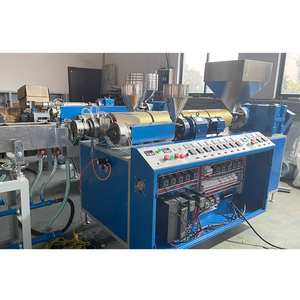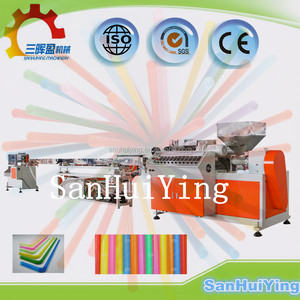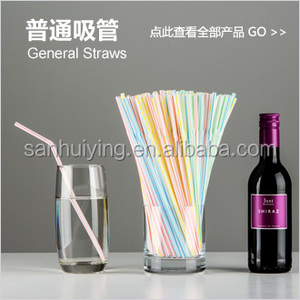
All categories
Featured selections
Trade Assurance
Buyer Central
Help Center
Get the app
Become a supplier

(1485 products available)



























The drinking straw extrusion machine provides the raw material in the form of molten plastic, which is then shaped into straws using different molds and cooling processes. The exact combination and order of these steps will vary depending on the specific type of extruder used.
All of these machines will have some common features, like the feeding system, heating system, and cooling system, but they will be adapted to suit the specific requirements of straw production.
A drinking straw silicone extrusion machine is a specialized piece of equipment used to manufacture drinking straws from silicone material. Silicone straws are reusable, flexible, and environmentally friendly alternatives to traditional plastic straws. The extrusion process involves shaping heated silicone material into consistent profiles to create straws. Silicone straw extrusion machines often involve multiple extrusion heads to produce multiple straws simultaneously, cutting systems to achieve the desired straw length, and specialized molds to shape the straws.
A drinking straw powder coating extrusion machine makes straws using powdered materials that liquefy when heated and form a straw when cooled. It uses an extruder, a die, a cooling method, and a cutting system.
Drinking straw extrusion machines have varying specifications depending on the types and models available. Such specifications include voltage, power, and the ability to produce straws of different lengths and thicknesses.
Maintaining the straw extrusion machine is crucial for its smooth and efficient operation. Regular maintenance can help prevent breakdowns, extend the machine's life span, and ensure the quality of the produced straws. Here are some crucial maintenance tips:
The advent of the drinking straw extrusion machine has revolutionized the production of drinking straws and brought about great changes to the market.
Industry: The Food and Beverage industry is the primary application industry for drinking straw extrusion machines. Such machines manufacture straws for various food and beverage products, which often serve as a necessary tool for consumer product consumption. Meanwhile, the high-speed and efficient production capacity of straw extrusion machines can meet the needs of large-capacity output, providing enough straws for the rapid development of the Food and Beverage industry.
Commercial: drinking straw extrusion machines are also widely used in commercial application scenarios. Stores, hotels, and restaurants are typical commercial venues that need to use a large number of drinking straws daily. The Drinking Straw Extrusion Machine can produce a variety of straws to meet different consumer needs and occasions.
Public and Medical: Public and healthcare application scenarios also have a demand for drinking straws. Institutions, hospitals, and other public health places need to use drinking straws to provide patients and customers with convenient, sanitary, and safe drinking tools. The sanitary and disposable characteristics of drinking straws make them widely used in the healthcare industry.
In summary, all kinds of drinking straw extrusion machines are the hero behind the scenes who provide fodder for all sections of life for our mouths.
Before investing, buyers should make a checklist of the essential features of a drinking straw extrusion machine. In this section, a few key attributes are listed for consideration.
Production Capacity
People use the drinking straw extrusion machine to create straws on a large scale. The production volume needs to match business requirements. If the machine can't produce enough, it will impact sales. When buying, compare the output numbers. Make sure they meet business needs. Invest in a machine that can make the quantity required to grow and succeed.
Straw Types
Customers use different types of straws for drinks. Some businesses want thin plastic straws, while others need thicker paper ones. Check if the extrusion machine can make the specific straws needed for particular customers. It should be able to produce the exact sizes and materials required to satisfy end-users. When choosing a machine, consider the different straw types that customers demand.
Flexibility and Efficiency
Customers want their straws delivered faster than ever before. As competition increases, it’s important to choose an extrusion machine that can adapt quickly to new straw designs and produce them efficiently. Look for a machine with interchangeable parts that can easily switch between straw styles. It should also work at high speeds without sacrificing quality. Investing in a versatile, fast machine now will help meet growing customer demands in the future.
Quality and Safety
Adrinking straw extrusion machine needs to be reliable during production. It should make straws of consistent quality that will not break or cause any problems for users. When selecting a machine, examine its construction carefully to ensure it is built well. In addition to being sturdy, the machine should also be easy to operate and safe for those who will be using it daily. Choose a model that balances durability with good usability and safety features.
Q1: How does the peanut butter making machine work?
A1: The drinking straw extrusion machine works on the principle of extrusion. First, the raw material is fed into the hopper. When the material is fed into the hopper, the rotating screw begins to turn and push the material forward. The material is heated and softened until it is molded into a straw. Finally, it is cooled and cut into desired lengths.
Q2: What are the raw materials for the drinking straw extrusion machine?
A2: The primary material is usually the MCAL, which is oxygenated polyphenylene styrene copolymer, along with food-grade colorants and additives.
Q3: Is the drinking straw extrusion machine eco-friendly?
A3: Eco-friendly straws are made from materials like wheat, apple peels, and sugarcane. These organic materials are biodegradable and are used as alternatives to plastic straws.
Q4: How much power does the drinking straw extrusion machine consume?
A4: The power consumption depends on the machine's capacity, model, and the material being extruded. On average, it can consume between 50 to 100 horsepower.